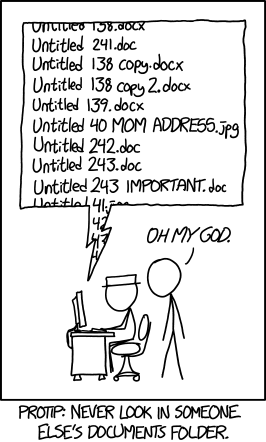File Naming Conventions

To maximize access to your records, we recommend establishing a naming convention for your files.
A file naming convention is a framework for naming your files in a way that describes what they contain and how they relate to other files.
File naming conventions help you stay organized and quickly identify your files. In a shared or collaborative group file-sharing setting, it will help others more easily navigate your work.
It is essential to establish a convention before you begin collecting files or data in order to prevent a backlog of unorganized content that will lead to misplaced or lost data!
Example File Names
No naming convention:
- Test data 2016.xlsx
- Meeting notes Jan 17.doc
- Notes Eric.txt
- Final FINAL last version.docx
With a naming convention:
- 20160104_ProjectA_Ex1Test1_SmithE_v1.xlsx
- 20160104_ProjectA_MeetingNotes_SmithE_v2.docx
- ExperimentName_InstrumentName_CaptureTime_ImageID.tif
Tips for File Naming
The following tips were adapted from Briney, K. A. (2020, June 2). File Naming Convention Worksheet. California Institute of Technology. This resource was recently awarded a 2023 DataWorks! Prize Significant Achievement Award.
Think about your files
What related files are you working with?
- Identify what group of files your naming convention will cover
- You can use different conventions for different file sets
- Check for established file naming conventions in your discipline or group
Example: This convention will apply to all of my microscopy files, from raw image through processed image.
Identify metadata (for example, date, sample, experiment)
What information is needed to easily locate a specific file?
- Experiment conditions
- Type of data
- Researcher name/initials
- Lab name/location
- Project or experiment name or acronym
- Date or date range of experiment
- A good format for date designations is YYYYMMDD. This format makes sure all of your files stay in chronological order. To add a timestamp to your filename, use the format YYYYMMDDThhmm.
- When using a sequential numbering system, use leading zeros for clarity and ensure files sort in sequential order. For example, use "001, 002, . 010, 011 . 100, 101 . " instead of "1, 2, . 10, 11 . 100, 101 . "
Example: For my images, I want to know the date, sample ID, and image number for that sample on that date.
Abbreviate or encode metadata
Don't forget to document any codes!
- Decide what shortened information to keep
- Standardize the categories and/or replace them with 2- or 3-letter codes
- Be sure to document these codes!
Example: Sample ID will use a code made up of: a 2-letter project abbreviation (project 1 = P1, project 2 = P2), a 3-letter species abbreviation (mouse = “MUS”, fruit fly = “DRS”), and 3-digit sample ID (assigned in lab notebook).
Use versioning
Are you maintaining different versions of the same file?
- Use versioning to indicate the most current version of a file
- Track versions of a file by adding version information to end of the file name, e.g. filename_v2.xxx
- Use a version number (e.g. “v01” or “v02”)
- Use the version date (use ISO 8601 format: YYYYMMDD or YYYY-MM-DD)
Think about how you will search for your files
What comes first?
- Think about how you want to sort and search for your files in order to determine the order for the metadata in the file name
- Decide what metadata should appear at the beginning
- Use default ordering: alphabetically, numerically, or chronologically
- Use ISO 8601-formatted dates (YYYYMMDD or YYYY-MM-DD)
Deliberately separate metadata elements
Avoid spaces or special characters in your file names

